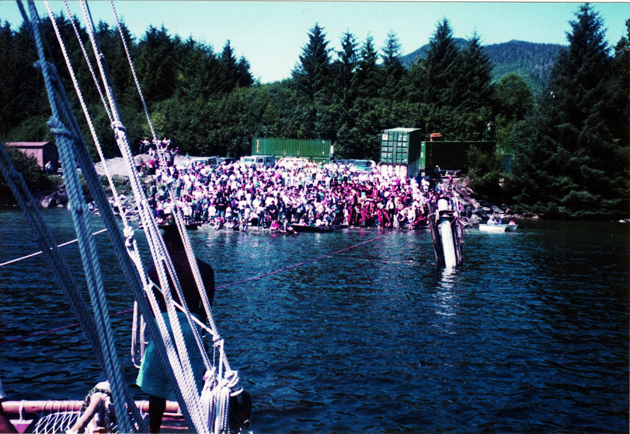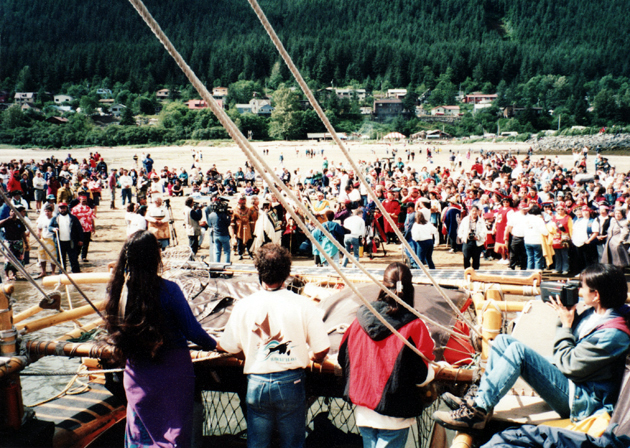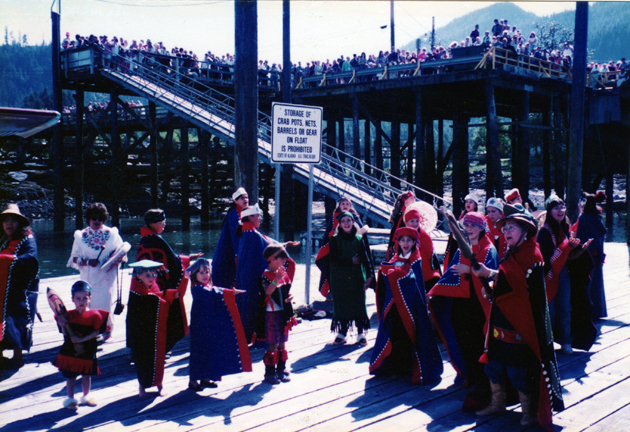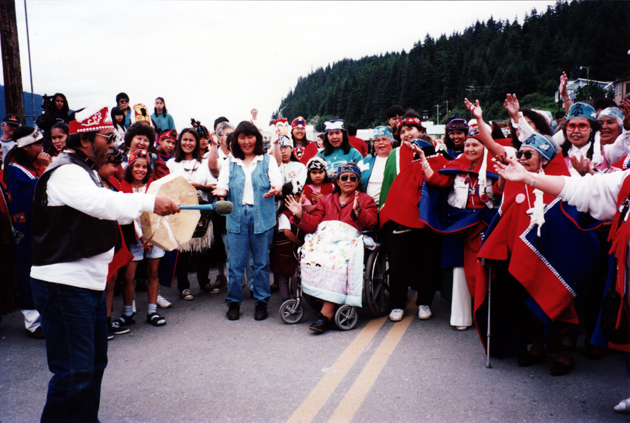Power of Cultural Exchange
In the year 1995, the newly completed Hawai’iloa undertook a series of cultural and educational exchanges, venturing to various destinations including Seattle, Vancouver and Juneau. The canoe made stops at several communities along the way, including Haines, Hoonah, Angoon, Kake, Petersburg, Wrangell, Ketchikan, Lowe Inlet and Bishop Bay. The chief purpose of this voyage was to convey heartfelt appreciation to Sealaska for the generous contribution of two Sitka spruce trees harvested from Sealaska lands, from which the Hawai’iloa’s hulls were carved. With this sailing, the Polynesian Voyaging Society (PVS) aimed to instill a sense of pride and honor within the Alaskan peoples by showcasing the value of the timber harvested for the canoe. Through this cultural exchange, the logs had been granted new life and now play a vital role in the revival and preservation of Hawaii’s voyaging traditions.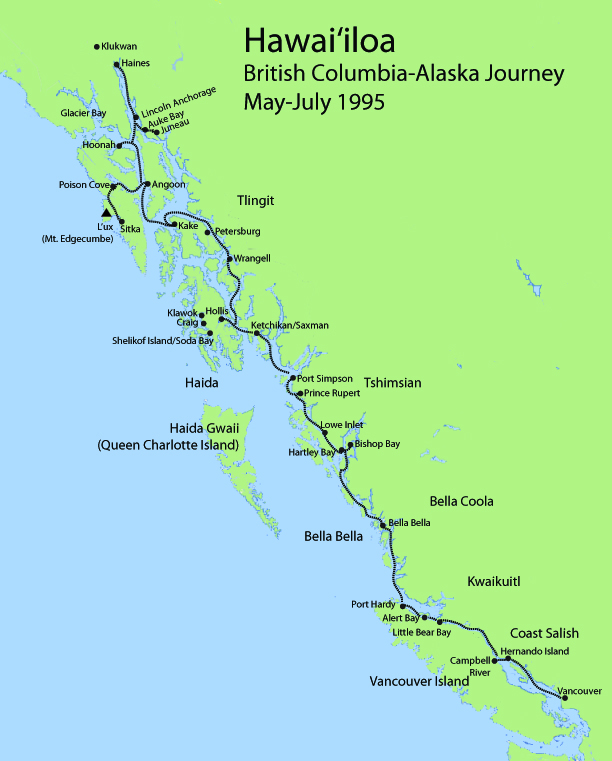
(Hawai’iloa's cultural and educational exchange journey through Alaska)
During this momentous expedition, the Polynesian Voyaging Society embarked on a journey filled with cultural exchanges, fostering connections with diverse Native communities across Southeast, whose existence is intricately intertwined with the bounties of the ocean and forest. Each village visited along the voyage hosted traditional welcoming ceremonies, characterized by heartfelt hospitality extended to the canoe and its crew. In the spirit of camaraderie, potlatches were shared, serving as occasions for mutual celebration and reciprocity, while traditional songs and dances from both cultures were enjoyed, uniting the participants in an expression of cultural heritage.
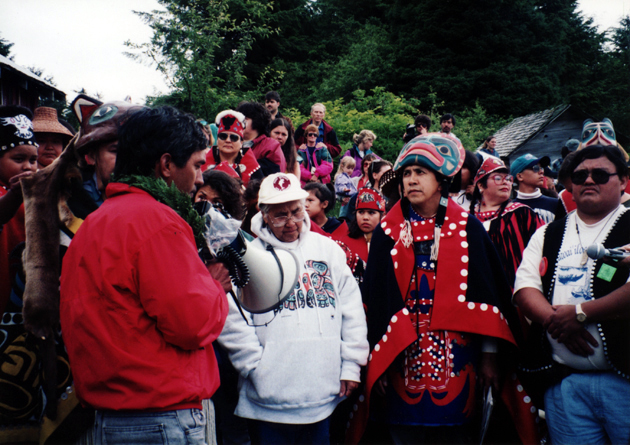
(Nainoa Thompson (with microphone), who joined the crew in Prince Rupert for the journey to Juneau, and Richard Jackson (in regalia), welcoming the Hawai‘iloa to Saxman.)
The journey’s secondary goal was to share information and educational materials on the values, practices and arts (including canoe building) that enabled the first peoples of the Pacific and Southeast Alaska to survive successfully in their respective environments for centuries; as well as each culture’s work to ensure continued health and productivity of their lands and seas for future generations. Upon their return to Hawai’i, the PVS team put the lessons they’d learned throughout their journey to educate students and the public in their communities about shared experiences with cultural and environmental challenges faced by relatives in Alaska, and the steps being taken to meet these challenges.
"We gave you wood to help you make your journey to your ancestral homelands. You gave us much more.
You have shared with us your civilization, your spirit, your dreams.
You have taught us that we can strive for and achieve the same kinds of things in the revival of our civilization."
- Elder Judson Brown to Nainoa Thompson, 1995
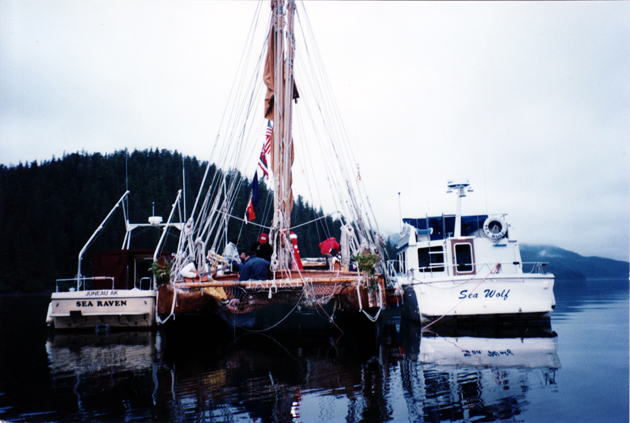
(Hawai’iloa (middle) escorted by Sea Raven piloted by Byron Mallott (left) and Sea Wolf piloted by Ernie Hillman (right))
During the leg of the journey from Ketchikan to Juneau, the Hawai‘iloa was joined by the Sea Wolf, a 30-foot fishing boat captained by Ernie Hillman of Sealaska. As the voyage continued onward to Sitka, the the two vessels were accompanied by the Sea Raven with Byron Mallot at the helm. As they paddled from Saxman to Haines, the Hawai’iloa was greeted by enthusiastic gatherings of Tlingit, Haida and Tsimshian communities along the shoreline. These warm receptions continued upon landing, as locals welcomed the Hawaiian crew with lively meals as they shared their culture through food, language, dance and song. These interactions helped reinforce all parties’ understanding of the unity and interconnectedness between all Pacific peoples.
At a potlatch commemorating the Hawai’iloa’s visit to Haines, Elder Judson Brown honored PVS president and esteemed navigator Nainoa Thompson with a Tlingit name —Xaat eesh [Kot eesh], meaning "Island Father." Brown shared the name’s origins with the potlach, explaining that it tells the story of a navigator and voyager, one who explores in hopes of finding islands.
Throughout the journey, the crew members of the Hawai‘iloa embraced the opportunity to share their Hawaiian heritage with all those they encountered. Under the guidance of Lilikala Kame'eleihiwa and Brad Cooper, they graced each port with performances of traditional Hawaiian songs and dances. Tava Taupu from Nukuhiva in the Marquesas Islands led the male crew and was joined by men from Juneau in an expressive dance depicting the pig-god Kamapua'a. The Eagle/Raven Dancers of Juneau, led by Agnes Bellinger, warmly embraced the Hawaiians into the fold, where they learned to perform Tlingit songs and dances alongside their relatives from across the sea. In a testament to their enthusiasm, two young crew members, Kala'i Miller and Kapono Aluli, were invited to join the Haida Dancers in their performance in Hollis. The entire crew was honored by a performance by the Mark Trail G̱eisán Dancers of Haines as they were welcomed to port.
During their stay in Hoonah, a remarkable cross-cultural workshop took place, uniting both cultures in their love of learning. Lilikala Kame'eleihiwa, a crew member of the Hawai’iloa and a professor of Hawaiian Studies at the University of Hawai'i Manoa, shared the notable achievements of the Hawaiian Language Immersion program in Hawai'i with Tlingit educators. She expressed her admiration for witnessing children engaging in fluent dialogue in the Hawaiian language, highlighting the effectiveness of the immersion method utilized in schools across Hawai’i. Kame'eleihiwa emphasized the potential this approach could hold for Lingít . She also emphasized the advantages she saw in the Hoonah community where fluent speakers could still be found, making the establishment of a school with a focus on language revitalization feasible.
Charting Course for a Sustainable Future
The strong relationship built between the Polynesian Voyaging Society (PVS) and Sealaska spans three decades, originating from the creation of the remarkable Hawai’iloa— an ocean-faring double-hulled canoe meticulously crafted in hopes of perpetuating the ancient art and scientific wisdom of traditional Polynesian voyaging. The collaborative journey undertaken by PVS when they built the Hawai’iloa and through her many voyages highlights the interconnectedness between people and planet. This has ignited an ever-growing network of partnerships that continue to inspire cultural and environmental revitalization across the Pacific and around the globe.In 1990, Sealaska presented a significant gift to PVS in the form of two Sitka spruce logs, which served as vital materials for constructing the revered Hawai’iloa canoe. This act of generosity brought attention to the critical state of Hawai‘i's forests while also symbolizing the essence of both "Aloha”, a Hawaiian concept which embodies deep love, peace and compassion; and the Tlingit value of “Woocheen”, which speaks to the power of partnership, working together and reciprocity.
The majestic forests of Southeast Alaska served as a wellspring of inspiration for PVS, prompting a collaboration with Kamehameha Schools to establish programs aimed at the revival of cultural and environmental vitality. One notable initiative, the Koa Reforestation Program, encouraged participants to planting native plants while inspiring further thought on the importance of working together to safeguard nature and preserve ancestral wisdom and traditions. The remarkable growth of the Keawewai Koa forest since the reforestation efforts began in 1990 is a visible testament to the enduring impact created through this work.
In anticipation of Hōkūle’a's forthcoming voyage, the Moananuiākea Voyage, the Polynesian Voyaging Society (PVS) and Kamehameha Schools orchestrated a gathering known as the Hoʻoilina Conference in 2019, graciously welcoming Sealaska to join them in Hawai'i. The primary objective of this conference was to continue nurturing the profound connection between the Alaska and Hawaiian communities, facilitating invaluable shared navigation and wayfinding traditions. Additionally, it served as a platform for celebrating the remarkable strides made in the revitalization of sacred forests, native languages, and envisioning a brighter future for the vast expanse of the Pacific Ocean. Above all, the conference provided an occasion to commemorate the enduring relationship between our respective communities and embracing our collective responsibility towards the lands and waters that sustain and nourish us.
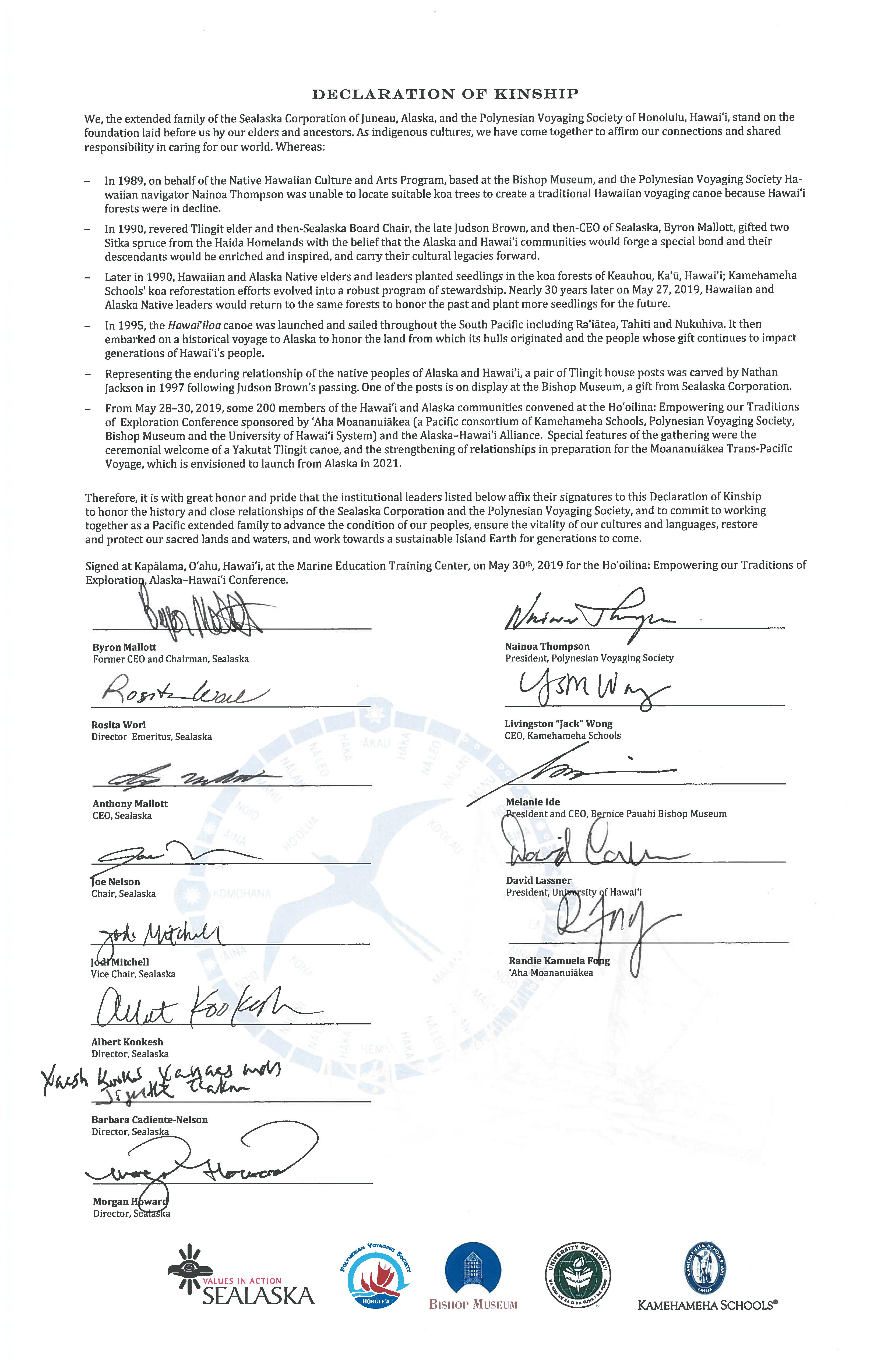
For additional information on Polynesian Voyage Society and the Moananuiākea Voyage, visit www.hokulea.com or follow @hokuleacrew on Facebook, Instagram, Twitter, and YouTube.
To learn more about Sealaska’s historical relationship with Polynesian Voyage Society, explore the links below:
A Voyage for Earth: This chapter follows the preparation and launch of the Moananuiākea Voyage, an ambitious journey of three canoes with a mission to unite Pacific communities and inspire a global education campaign centered on indigenous knowledge and ocean stewardship.
Regional Sailing Plan:Follow Hokulea as PVS voyages an estimated 43,000 nautical miles around the Pacific, visiting 36 countries and nearly 100 indigenous territories.
Uniting a Pacific Legacy: This chapter introduces the PVS and Sealaska’s historical relationship, highlighting the shared values and traditions that connect them across the vast Pacific Ocean.
Birth of Hawai’iloa: This chapter follows the story of the creation of Hawai’iloa, the symbolic voyaging canoe that embodies the spirit of Polynesian exploration and the mission to care for the Earth.
Key Leaders Inspiring Generations: In the final chapter, the focus is on our ancestors that, to this day, continue to guide us with wisdom and deep belief in the traditional values of our people.
